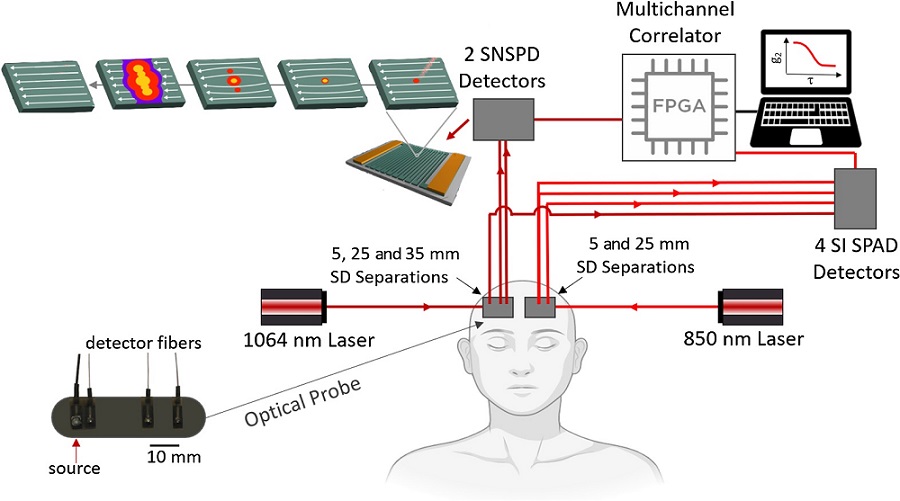BOSTON, Aug. 24, 2021 — Researchers from Massachusetts General Hospital and MIT Lincoln Laboratory have developed a superconducting nanowire single-photon detector (SNSPD)-based diffuse correlation spectroscopy (DCS) device. The instrument demonstrated a high signal-to-noise ratio and high sensitivity for blood flow.
This study marks one of the first-ever applications of SNSPDs in a biomedical setting, the researchers said. DCS involves the illumination of tissues with near-infrared laser rays. The light is scattered by the movement of red blood cells and the resulting pattern is analyzed by a detector to determine blood flow.
DCS is a useful technique for the measure of cerebral blood flow, which itself is a sensitive marker of cerebrovascular function. The ideal operating conditions for accurate measurement are large source-detector (SD) separation, of greater than 30 mm; high acquisition rates; and longer wavelengths, of greater than 1000 nm.
However, current DCS devices, which use single-photon avalanche photodiode (SPAD) detectors, are unable to attain that ideal. Due to high signal-to-noise ratio and low photon efficiency, they cannot allow an SD separation greater than 25 mm or wavelength greater than 900 nm.

Representation of the setup used for blood flow measurement using superconducting nanowire single-photon detector and single-photon avalanche photodiode diffuse correlation spectroscopy systems. Courtesy of Ozana et al.
SNSPDs consist of a thin film of superconducting material with excellent single-photon sensitivity and detection efficiency. Commonly used in telecommunications, optical quantum information, and space communications, SNSPDs are seldom used in biomedicine, though they outperform SPADs in multiple parameters, such as time resolution, photon efficiency, and range of wavelength sensitivity.
To demonstrate the operational superiority of the SNSPD-DCS system, the researchers conducted cerebral blood flow measurements on 11 participants using both SNSPD-DCS and SPAD-DCS systems provided by Quantum Opus. The SNSPD-DCS system operated at a wavelength of 1064 nm with two SNSPD detectors. The SPAD-DCS system operated at 850 nm.
The SNSPD-based DCS system showed significant improvement in SNR compared to the conventional SPAD-based DCS. This improvement was attributable to two factors. First, with illumination at 1064 nm, the SNSPD detectors received 7× to 8× more photons than the SPAD detectors received at 850 nm. Second, SNSPD has a higher photon detection efficiency (88%) than SPAD’s photon detection efficiency of 58%.

While the SPAD-DCS could allow signal acquisition only at 1 Hz at 25 mm SD separation owing to low SNR, the 16× increase in SNR for the SNSPD-DCS system allowed signal acquisition at 20 Hz at the same SD separation allowing clear detection of arterial pulses.
As cerebral blood flow sensitivity increases substantially for measurements taken at larger SD separation, the researchers also performed measurements at 35 mm SD separation. The SNSPD-DCS system recorded a 31.6% relative increase in blood flow sensitivity. The SPAD-DCS system could not be operated at 35 mm SD separation because of its low SNR.
Measurements taken during breath-holding and hyperventilation exercises then validated the performance of the SNSPD-DCS system. Theoretically, blood flow increases during the first 30 seconds of breath-holding and slowly returns to normal thereafter. During hyperventilation, blood flow to the scalp increases and blood flow to the brain decreases. SNSPD-DCS measurements showed an increase of 69% and a decrease of 18.5% in relative cerebral blood flow for breath-holding and hyperventilation, respectively. The measurements were in agreement with those obtained from PET and MRI studies.
The SNSPD-DCS system facilitates higher photon collection, larger SD separations, and higher acquisition rates, leading to better accuracy. Given these advantages, the researchers believe the system may allow for a noninvasive and more precise measurement of cerebral blood flow — an important marker of cerebrovascular function — for adult clinical applications.
The research was published in Neuromorphics (www.doi.org/10.1117/1.NPh.8.3.035006).